Speech Building on Strong Foundations

Philip Lowe
[*]
Deputy Governor
Address to the Australian Business Economists (ABE) Annual Dinner
Sydney –
- Summary
- Audio 27.33MB
- Q&A Transcript
Thank you for inviting me back to the Australian Business Economists' annual dinner. It is an honour for me to be able to speak again in front of so many of Australia's leading business economists.
Before I turn to my main topic this evening, I would like to pay tribute to one of my predecessors who passed away earlier this month – and that, of course, is John Phillips. John served the Reserve Bank of Australia (RBA) (and before that the Commonwealth Bank) for more than four decades, and between 1987 and 1992 sat in the office that I now occupy. John epitomised the first of the RBA's core values – that of serving the public interest. He did this with great dedication during his time at the RBA and in his highly distinguished subsequent career. At the RBA, John worked tirelessly to modernise Australia's financial and monetary system, and to modernise the RBA itself. The institution that I now serve, as well as the broader Australian community, owe him a considerable debt. John will be sorely missed.
When I last spoke at this dinner, two years ago, the title of my remarks was ‘What is Normal?’.[1] My thesis was that as a country, we were going through a difficult adjustment in expectations. Over the decade or so to the late 2000s we had got used to consumption growing more quickly than income. We had also got used to asset prices, credit and fiscal revenues growing more quickly than income. We had got used to employment increasing more rapidly than the working-age population. And we had got used to growth in our real incomes outpacing the rate at which we were improving our productivity.
We started to think that this was normal. Retailers thought it natural that their sales grew more quickly than people's incomes. Many investors thought that earning capital gains on their existing assets was the key to wealth creation. Banks got used to very fast growth in their balance sheets. And we all got used to the annual tax cuts that came from strong revenue growth.
But these trends were not normal. And so two years ago, my thesis was that the dawning realisation of this was affecting the national psyche.
Two years on, I think we better appreciate the uniqueness of the earlier episode and there has been some realignment in expectations. But I suspect that this realignment is not yet over and it is one of the things that continues to weigh on the national economic mood. Also weighing on this mood is the prospect of the so-called ‘end’ of the mining boom. As a result, I sense a degree of nervousness about our future among some commentators who sometimes ask: what happens to Australia after this boom is over?; how can Australian businesses compete internationally given our high costs?; and, where will the jobs come from in the future?
These are all good questions. But if I return to another theme from two years ago, it is that uncertainty is also normal. Given this, it is important that we guard against the possibility that this uncertainty mutates into chronic pessimism – that is, for it to become normal for us to think that our prospects are limited. If this were to become our normal mindset, then we would be well on the way to finding ourselves in the very world that we feared.
So this evening, I would like to turn my eyes to the future and talk a little about how the economy might look someway down the track. My central thesis tonight is twofold. First, the Australian economy does have the foundations for a successful and prosperous future. And second, how well we take advantage of those foundations depends increasingly on investment not in physical capital, but in human capital.
An Aspiration
So looking forward, what type of economy should we be aspiring to?
One could answer this in many different ways. But I think a reasonable answer would be a highly productive, globally competitive economy that is operating close to, or at, full employment.
Such an economy would be characterised by: a national currency with sustainably high purchasing power; sustainably high real wages; and sustainably high real returns on capital. High purchasing power and high wages mean that for each hour that we work we are able to buy more goods and services. And high returns mean that savers get rewarded when they take a risk or defer their spending and save for the future.
If we are to meet this aspiration then we need to be an economy where value added is high.
We need to be able to produce a range of goods and services very efficiently and/or be able to sell goods and services at a premium price because of their quality, their uniqueness or some other favourable attribute. This is true right across the industry spectrum. It is true in advanced manufacturing. It is true in the tourism industry. It is true in agriculture. And, it is true in the technology sector and in business and household services. In the end, it is unlikely that we can achieve this aspiration by simply selling standardised, homogeneous, mass-produced goods and services on the world market. We need to be at the high value-added end in much of what we do.
And this is why investment in human capital is so important. It is through human capital that we can create the goods and services that can deliver on this aspiration. The quality of our human capital is critical to our ability: to solve complex problems; to develop and use technology; to deliver premium quality goods and services; and to respond quickly and well to an ever-changing world.
So one of the challenges that lies ahead is to create the environment that encourages the investment in human capital that is ultimately required to sustain the high living standards and high returns to savers that we should be aspiring to. I want to return to this challenge in a few moments.
Cyclical Considerations
Before I do, though, it is important to recognise that the exchange rate, wages and the return to saving each also play a key role in how the economy is performing at any point in time.
In terms of the exchange rate, the RBA has been saying for a while now that a lower value of the Australian dollar would be helpful from an overall macroeconomic perspective. If the exchange rate is to play its important stabilising role, it needs to go down when the terms of trade and investment are declining, just as it went up when the terms of trade and investment were rising. To date, as we expected, we have seen some adjustment, but if our assessment of the fundamentals is correct we would expect to see more in time.
In terms of wages, there is sometimes commentary bemoaning their high level in Australia. There are, no doubt, certain areas where wages are very high and working conditions are highly favourable and some adjustment is likely to be required. But it is also useful to recall that over the past two decades or so, aggregate wage outcomes have been consistent with the inflation target and with a trend decline in the unemployment rate. They have also been associated with a fairly low share of wages in national income. While we need to pay close attention to overall labour costs, these observations point to the conclusion that concerns about the overall level of wages in Australia are, to some extent, really concerns about the exchange rate, with the high exchange rate leading to high wages expressed in foreign currency terms. A lower exchange rate would obviously make a difference to these comparisons.
In terms of the return to saving, it is currently very low. As I spoke about last month, this largely reflects global factors.[2] A lack of investment around the world, relative to people's desire to save, means that savers everywhere are being offered low returns on their savings in bank accounts. This is causing them to look elsewhere, which, in turn, is pushing up the price of existing assets.
So from a cyclical perspective – and largely as a result of global factors – our exchange rate is unusually high and, at the same time, savers are being offered unusually low returns. Of course, Australia is not unique in being in this position. And this particular configuration is causing complications for macroeconomic management here as well as in a number of other countries.
But as we deal with these complications we should not lose sight of the longer-term challenge of building a highly productive, globally competitive economy.
We should have some confidence that we are able to do this. We certainly have a number of strong foundations that provide the basis for this optimism. The question is how well we can use those foundations over the years ahead.
Some Strong Foundations
Rather than go through all of these strong foundations, I would like to draw your attention to just three.
The first is our linkages with the fastest growing part of the world economy – namely Asia.
I am sure you all know the facts about the trade relationship. Exports to Asia are up by around 30 per cent over the past five years. Our three largest export destinations – China, Japan and South Korea – are all in the Asian region and free trade agreements have been concluded with each of them recently.
But the aspect of the relationship that I would like to focus on is the people-to-people relationship.
Currently, around 8 per cent of the Australian population was born in east and south-east Asia or India (Graph 1). This is up from less than 1 per cent of the population around the time that I was born. In comparison, in the United States, only around 3½ per cent of the population was born in Asia and for most European countries the figure is below 2 per cent.
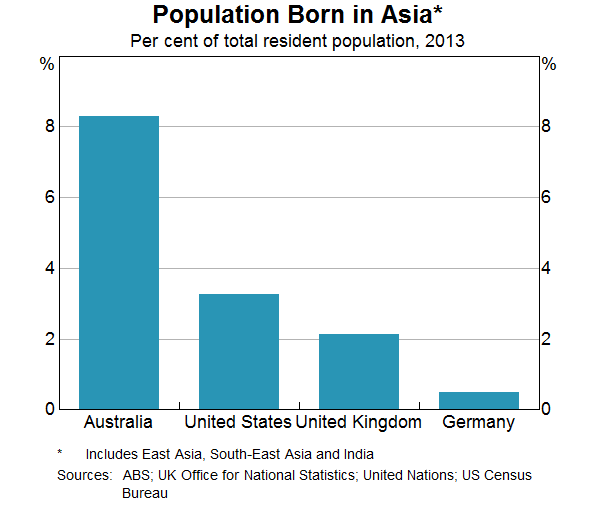
There are also large numbers of students from Asia studying in Australia. Currently there are around 150,000 Chinese student enrolments at Australian educational institutions, more than double the number a decade ago (Graph 2). There are also large numbers of students from India, South Korea, Malaysia, Thailand, Vietnam and Singapore. All up, there are more than a quarter of a million Asian students studying here. In time, these students will add to the already vast network of our alumni across the region.
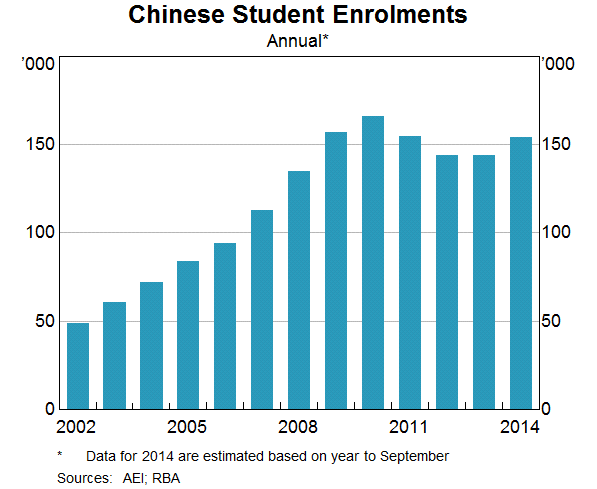
The strong people-to-people linkages can also be seen in the broader data on international short-term arrivals (Graph 3). At the moment, more than 250,000 citizens from Asia are travelling to Australia every month, with arrivals from China reaching nearly 80,000 a month. As is evident from the graph, these figures have grown very strongly over recent years. There has, of course, also been very strong growth in the number of Australians travelling to Asia for both business and leisure.
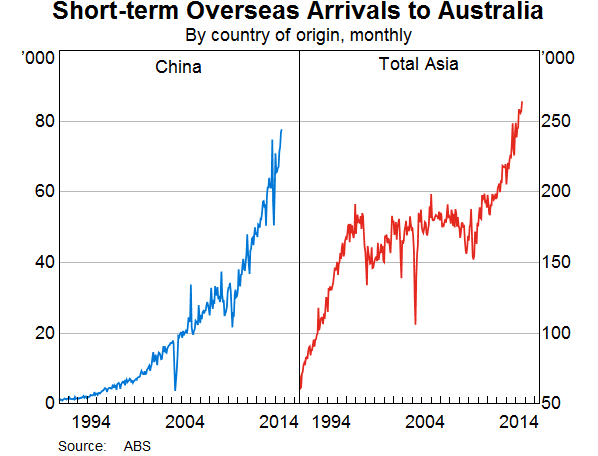
Taken together, this deep and growing people-to-people engagement is an increasingly important national asset. It helps us better understand the most dynamic part of the global economy. It promotes goodwill and can help identify cross-border business opportunities. Some of the students studying here will hopefully become ‘champions’ for our country when they return home. Others will remain here and use their knowledge and relationships in their country of birth to build new and stronger business ventures between our countries.
The second foundation that I would like to point to is our strong overall population growth. Over the past decade, Australia has had almost the fastest rate of population growth in the OECD and this is expected to continue for some time to come (Graph 4). In a decade's time, our population is forecast to be 17 per cent higher than it is today – that is an extra four million people.
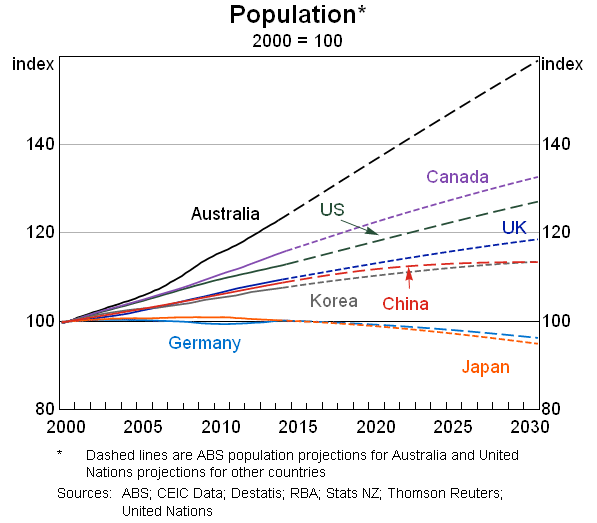
These people will require somewhere to live, to work and to play. This population growth helps underpin the creation of new opportunities for businesses and for individuals. It means that people can plan with the knowledge that the overall size of the pie is getting bigger. Contrast that to the situation in Japan where, over the next decade, the population is expected to decline by about as many people as currently living in Melbourne. In Australia, we are likely to add roughly another Melbourne to our population over this period.
The third foundation that I want to point to is our considerable endowment of natural resources, both in terms of minerals and agricultural land. One illustration of the recent benefit that Australia has gained from its minerals is the large rise in export revenue. For many years, revenue from resource exports was equivalent to around 5 to 7 per cent of GDP, but recently it has averaged double this, at around 12 per cent of GDP (Graph 5). With a large increase in LNG exports still to take place it is possible that this ratio will increase even further, although this will also depend on how the prices of our exports evolve.
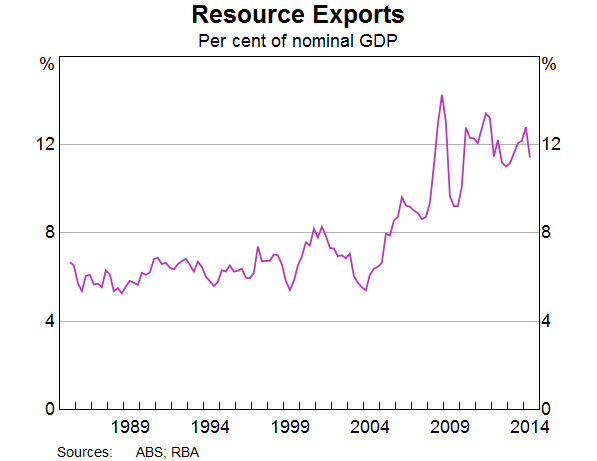
While not all the extra revenue accrues to Australian residents because of the high levels of foreign ownership in the resources sector, this increase has helped boost our average standard of living. Notwithstanding the current focus on the decline in mining investment, we should not lose sight of the fact that this extra export revenue, which has been made possible by the investment in extra capacity, has made us better off and has created opportunities that we would otherwise not have had.
In terms of strong foundations, I could have also talked about our strong institutions, our capable public sector, our generally flexible economy, a strong financial sector, low levels of government debt and generally healthy corporate balance sheets.
Collectively, these various factors have helped deliver average living standards in Australia that are among the highest on the planet, and they have given us opportunities that are available to only a few other countries.
Taking Advantage of the Opportunities?
How then do we make the best of these opportunities?
There is of course no single answer here. But I find it difficult to escape the conclusion that investment in human capital is central to taking advantage of the opportunities that we have built for ourselves.
Looking at where the jobs have been created over the past couple of decades, two trends stand out. The first is the fact that the largest increase has been in jobs with higher level qualifications (Graph 6). The second is that, in terms of industries, the bulk of the new jobs have been in services, with over 3½ million service industry jobs having been created since the early 1990s (Graph 7). These jobs are in health, education, personal services, retailing, finance, engineering, information technology, software design, telecommunications – the list goes on. In contrast, just over half a million jobs have been created in the so-called goods-producing industries – manufacturing, mining, construction and utilities. And given the first trend, many of these jobs – both in the services and in goods-producing industries – have required higher levels of skills.
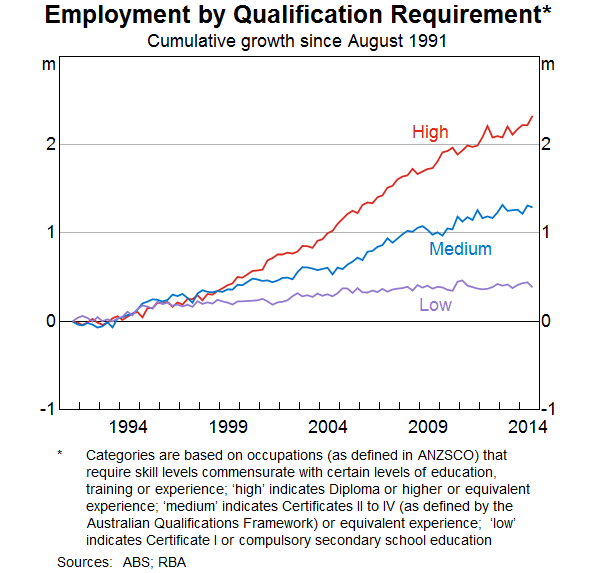
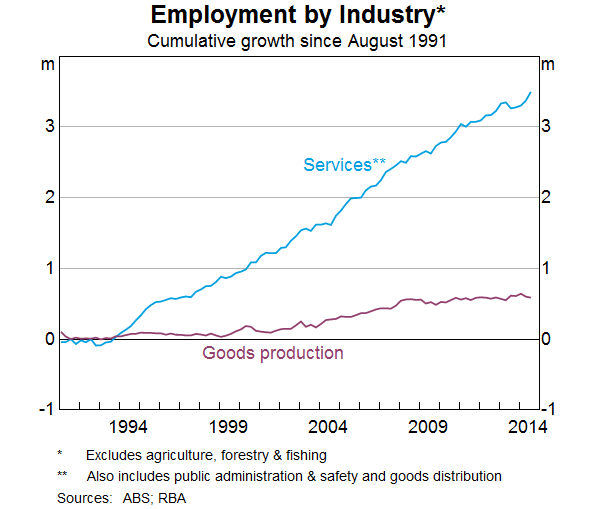
It would seem, therefore, that our future is increasingly dependent upon high-level cognitive skills and our ability to understand and solve complex problems. It depends upon having people who are curious, who are able to grasp new opportunities and who are able to transform and interpret information in new ways. And it depends on having the interpersonal skills to provide the premium services that will attract the premium price. Business practices everywhere are being reshaped and disrupted by developments in information technology. This is true not just in the service industries but also in manufacturing, with much of today's innovative capital equipment as dependent on the software that runs it as it is on the quality and ingenuity of the physical engineering.
How to best take advantage of this new world is not the core expertise of the central bank. But I would like to make three observations.
The first is the importance of culture.
The type of human capital that is likely to be required in this world is best developed in a culture that promotes and rewards innovation and excellence, whether it is in services, goods, resources or agriculture.[3] It is best developed in a culture that encourages entrepreneurship and for people to take a risk with a new idea. And it is best developed in a culture that promotes creativity and flexibility. Developing and sustaining such a culture takes effort across a whole range of areas. So if we hope to make the best of our opportunities then we should all be asking what we can do here.
The second observation is the importance of ensuring that our workforce has an appropriate mix of sophisticated skills to produce premium goods and services.
These skills are those required to solve complex problems, identify new opportunities and deliver high-quality customer experiences. Creativity – in all its dimensions – is a key element here. One of the areas that deserves close attention is the STEM subjects – science, technology, engineering and mathematics. Over the years, Australia has done reasonably well here, but the share of Year 12 students studying higher level mathematics and the sciences has been in decline for many years now (Graph 8).[4] I might also add that in our schools, considerably more young men study many of these subjects than do young women. Unfortunately, this is also true for the study of economics. In terms of the international tests, our scores have been relatively high, although they too have tended to slip a bit over recent years (Graph 9).[5] Looking beyond the STEM skills, we need to build a creative, innovative and flexible workforce.
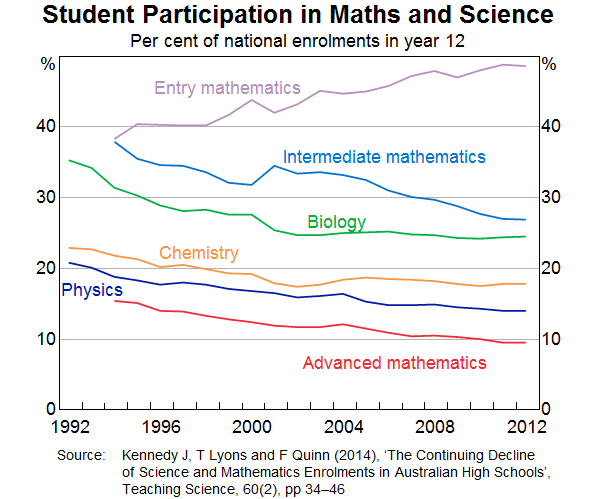
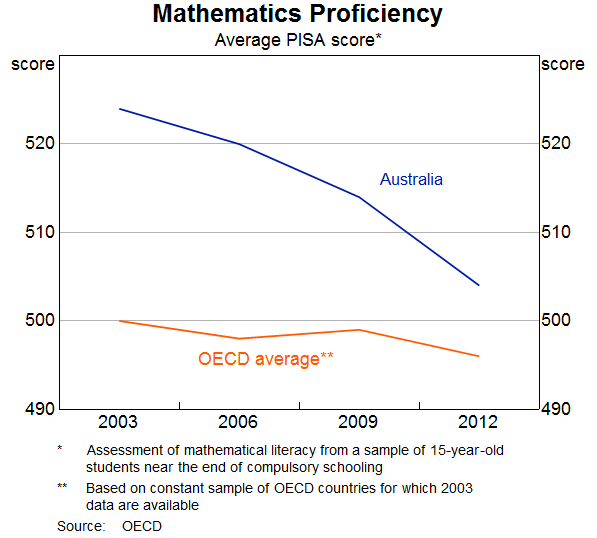
And the third observation is the need to find ways of deepening collaboration between our universities and businesses.
Australia has some tremendous places of higher learning. But as a number of reports have recently highlighted, the collaborative research connections between these universities and private business are not well developed by international standards.[6] According to many entrepreneurs, strong collaboration and networking are critical elements in the development of the type of innovation ecosystems in which new ideas can best flourish and be commercialised. So this is an area to which we need to pay close attention.
Conclusion
I know I have strayed a long way from the setting of the cash rate, which I also know is of keen interest to many of you. But, in a very real sense, the issues that I have spoken about tonight do have implications for monetary policy. The reason that the world has such low interest rates at the moment is that people's desire to save outstrips their desire to create new assets. A stronger global investment environment would be likely to see global interest rates rise and this is something that we should all hope occurs sooner rather than later.
The issue that many countries are struggling with is how to do this – that is, how to improve the investment climate. Very accommodative monetary policy is playing a role here. But there are some real limitations to this and, in some countries, these limitations are becoming increasingly evident. What is needed is a genuine improvement in the underlying investment climate.
And so this is where the issues that I have talked about tonight come in. The Australian economy clearly has some challenges ahead, but we would be selling ourselves short if we dwelt exclusively on these challenges. Our economy does have some very strong foundations upon which we can build – I have talked about our links with Asia, our dynamic population and our natural resources. These foundations give us opportunities that few countries have. They should also provide us with some confidence that new investment can deliver reasonable returns. This sense of confidence would be enhanced by further steps to improve the environment for the accumulation of human capital. If we are able to do this, then I hope that it would become normal for us to live in a highly productive, globally competitive economy with sustainably high living standards and returns to savers.
Thank you for listening and I look forward to any questions that you might have.
Endnotes
I would like to thank David Jacobs for excellent assistance in the preparation of this talk. [*]
See Lowe P (2012), ‘What is Normal?’ Address to the Australian Business Economists Annual Dinner, Sydney, 5 December. [1]
See Lowe P (2014), ‘Investing in a Low Interest Rate World’, Address to the Commonwealth Bank of Australia's 7th Annual Australasian Fixed Income Conference, Sydney, 21 October. [2]
See Australian Government (2014), Industry Innovation and Competitiveness Agenda, Commonwealth of
Australia, Canberra. Available at <http://www.dpmc.gov.au/publications/Industry_Innovation_and_Competitiveness_Agenda/
docs/industry_innovation_competitiveness_agenda.pdf>.
[3]
Kennedy J, T Lyons and F Quinn (2014), ‘The Continuing Decline of Science and Mathematics Enrolments in Australian High Schools’, Teaching Science, 60(2), pp 34–46. [4]
See Thomson S, L De Bortoli and S Buckley (2013), PISA 2012: How Australia Measures Up, Australian Council for Educational Research, Camberwell, Victoria. Available at <http://www.acer.edu.au/documents/PISA-2012-Report.pdf> [5]
For example, see OECD (2013), OECD Science, Technology and Industry Scoreboard 2013: Innovation for Growth, OECD Publishing, available at <http://www.oecd-ilibrary.org/science-and-technology/oecd-science-technology-and-industry-scoreboard-2013_sti_scoreboard-2013-en>, and Schwab K (ed) (2013), The Global Competitiveness Report 2013–2014, World Economic Forum, Geneva, available at <http://reports.weforum.org/the-global-competitiveness-report-2013-2014/>. [6]
Bibliography
Kennedy J, T Lyons and F Quinn (2014), ‘The Continuing Decline of Science and Mathematics Enrolments in Australian High Schools’, Teaching Science, 60(2), pp 34–46.